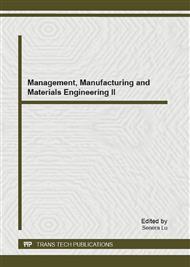[1]
N. Russell, A.H.M. ter Hofstede, D. Edmond, and W.M.P. van der Aalst. Workflow Data Patterns. QUT Technical report, FIT-TR-2004-01, Queensland University of Technology, Brisbane, (2004).
Google Scholar
[2]
M. Pesic, H. Schonenberg, and W. Aalst, Declarative Workflow, , A. H. M. Hofstede, W. M. P. Aalst, M. Adams, and N. Russell, Ed., Springer Berlin Heidelberg, 2010, pp.175-201.
DOI: 10.1007/978-3-642-03121-2_6
Google Scholar
[3]
M. Pesic and W. van der Aalst, A Declarative Approach for Flexible Business Processes Management, , J. Eder and S. Dustdar, Ed., Springer Berlin / Heidelberg, 2006, vol. 4103, pp.169-180.
DOI: 10.1007/11837862_18
Google Scholar
[4]
Gerth R, Peled D, Vardi M Y, et al. Simple on-the-fly automatic verification of linear temporal logic. In: Proc. 15th Work. Protocol Specification, Testing, and Verification. Warsaw, Poland, 1995: 3-18.
DOI: 10.1007/978-0-387-34892-6_1
Google Scholar
[5]
Gastin P, Oddoux D. Fast LTL to Büchi automata translation. Lecture Notes in Computer Science, 2001, 2102: 53-65.
DOI: 10.1007/3-540-44585-4_6
Google Scholar
[6]
M. Pesic, H. Schonenberg, and W. M. P. van der Aalst, DECLARE: Full Support for Loosely-Structured Processes. Washington, DC, USA: IEEE Computer Society, 2007, p.287.
DOI: 10.1109/edoc.2007.14
Google Scholar
[7]
Giannakopoulou D, Lerda F. Efficient translation of LTL formulae into Büchi automata. In: RIACS Technical Report. (2001).
Google Scholar
[8]
M. Pesic, M. Schonenberg, N. Sidorova, and W. van der Aalst, Constraint-Based Workflow Models: Change Made Easy, , R. Meersman and Z. Tari, Ed., Springer Berlin / Heidelberg, 2007, vol. 4803, pp.77-94.
DOI: 10.1007/978-3-540-76848-7_7
Google Scholar
[9]
Giannakopoulou D, Lerda F. From states to transitions: Improving translation of LTL formulae to Büchi automata. Lecture Notes in Computer Science, 2002, 2529: 308-326.
DOI: 10.1007/3-540-36135-9_20
Google Scholar
[10]
A. Bauer, M. Leucker, and C. Schallhart. Comparing LTL Semantics for Runtime Verification. Logic and Computation, 20(3): 651-674, (2010).
DOI: 10.1093/logcom/exn075
Google Scholar
[11]
REGEV G, SOFFER P, SCHMIDT R. Taxonomy of flexibility in business processes[EB/OL](2006-06-06)[2009-09-07].
Google Scholar


